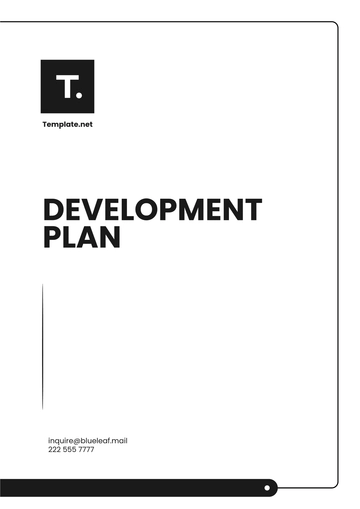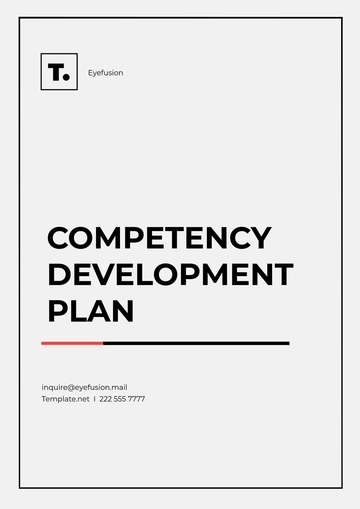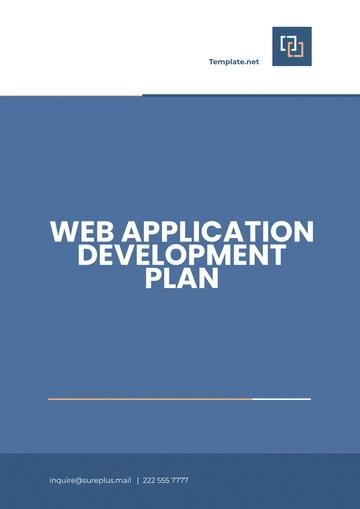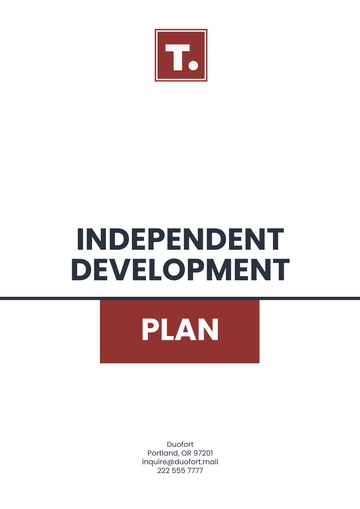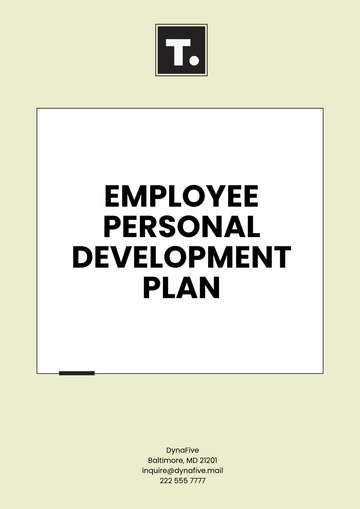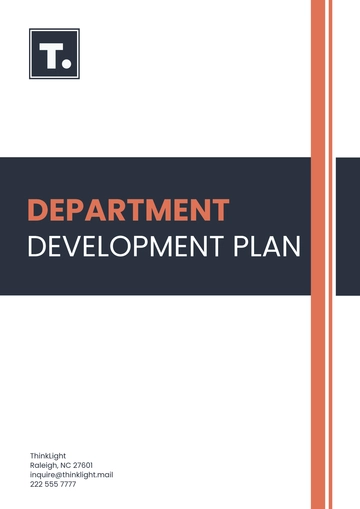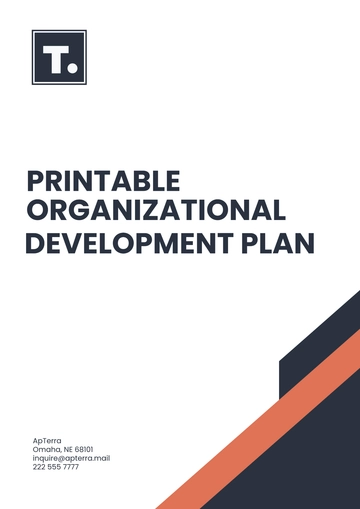Free Agriculture Infrastructure Plan
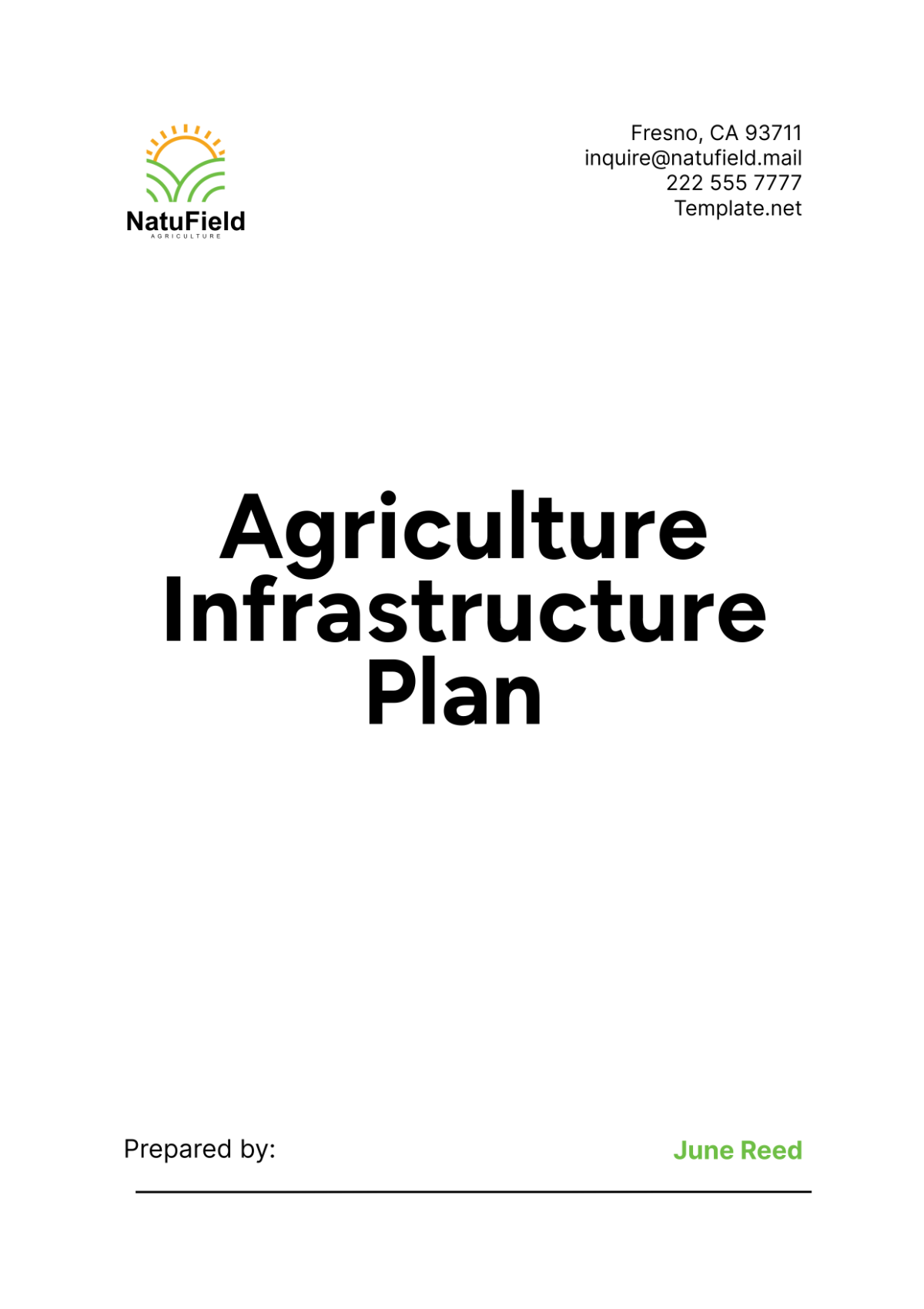
Executive Summary
This Agriculture Infrastructure Plan is prepared by [Your Company Name] to outline the strategic framework for enhancing and expanding our agricultural infrastructure. The plan aims to support increased production capacity, improve operational efficiency, and ensure sustainable practices. The document details our current infrastructure status, the need for enhancements, proposed projects, financial projections, and implementation timelines.
1. Introduction
1.1 Purpose of the Plan
The primary purpose of this infrastructure plan is to provide a comprehensive roadmap for the development and enhancement of our agricultural infrastructure. The plan aims to address several critical areas essential for the growth and sustainability of [Your Company Name]. Here, we delve deeper into each purpose and its significance:
Expanding Production Capacity
To meet the growing market demand, it is imperative to increase our production capacity. The expansion of production capacity involves several strategic initiatives:
Land Acquisition and Development: By acquiring additional land, we can increase the area under cultivation, allowing us to grow more crops and diversify our product offerings. This expansion will not only help in meeting the current market demand but also enable us to cater to new markets and customer segments.
Improving Yield Per Acre: Through the adoption of advanced farming techniques and high-yield crop varieties, we aim to maximize the productivity of our existing and newly acquired land. This includes precision farming practices that optimize the use of inputs such as water, fertilizers, and pesticides.
Scaling Operations: Increasing production capacity also involves scaling up our operations, which includes expanding our workforce, enhancing storage facilities, and upgrading transportation logistics to handle larger volumes of produce.
Improving Operational Efficiency
Operational efficiency is crucial for maintaining competitiveness and profitability. By modernizing equipment and practices, we aim to streamline our operations and reduce costs:
Modern Equipment: Investing in state-of-the-art machinery and equipment is essential for improving efficiency. Modern tractors, harvesters, and seeders can perform tasks faster and more accurately, reducing labor costs and minimizing errors.
Technology Integration: Incorporating technology such as GPS-guided equipment, automated irrigation systems, and data analytics can significantly enhance operational efficiency. These technologies enable precise application of inputs, real-time monitoring of crop health, and data-driven decision-making.
Process Optimization: Evaluating and optimizing our current farming practices and processes to eliminate inefficiencies. This includes better planning and scheduling of activities, reducing downtime, and ensuring timely maintenance of equipment.
Ensuring Sustainability
Sustainability is a core value for [Your Company Name], and integrating sustainable practices and technologies is vital for long-term success:
Water Management: Implementing advanced irrigation systems such as drip and sprinkler irrigation to ensure efficient water use. These systems not only conserve water but also improve crop yields by providing consistent moisture levels.
Soil Health: Promoting soil health through practices such as crop rotation, cover cropping, and the use of organic fertilizers. Healthy soil is more resilient to erosion and degradation, supporting sustainable crop production.
Renewable Energy: Reducing our carbon footprint by incorporating renewable energy sources such as solar panels and wind turbines. This shift not only supports environmental sustainability but also reduces long-term energy costs.
Waste Management: Establishing comprehensive waste management programs to recycle and compost organic waste. Effective waste management minimizes environmental impact and promotes a circular economy.
By focusing on these three primary objectives, this infrastructure plan aims to create a robust foundation for sustainable growth, operational excellence, and environmental stewardship.
1.2 Scope of the Plan
This infrastructure plan covers several key areas, each crucial for the comprehensive development and enhancement of our agricultural operations. The scope includes:
Current Infrastructure Assessment
A thorough assessment of our existing infrastructure is the first step in the planning process. This assessment includes:
Land and Cultivation Areas: Evaluating the current state of our cultivated land, including soil health, crop productivity, and potential for expansion.
Irrigation Systems: Assessing the efficiency and coverage of our existing irrigation systems to identify areas that require upgrades or expansion.
Storage and Post-Harvest Facilities: Inspecting our storage facilities and post-harvest handling processes to ensure they are capable of supporting increased production and maintaining product quality.
Machinery and Equipment: Reviewing the condition and performance of our current machinery and equipment, identifying those that need replacement or upgrades.
Proposed Infrastructure Enhancements
Based on the assessment, we outline the proposed enhancements required to achieve our objectives:
Land Expansion and Development: Detailed plans for acquiring and developing additional land, including necessary infrastructure such as roads and fencing.
Irrigation System Upgrades: Plans to expand and modernize our irrigation systems to improve water use efficiency and ensure uniform distribution.
Storage and Post-Harvest Enhancements: Strategies to expand our storage capacity and upgrade post-harvest facilities to handle increased production and improve product handling.
Machinery and Equipment Upgrades: Proposals for purchasing new machinery and equipment, and implementing maintenance programs to ensure optimal performance.
Financial Projections and Budget
A comprehensive financial plan that includes:
Budget Allocation: Detailed budget for each proposed enhancement project, ensuring that all costs are accounted for.
Financial Projections: Projected financial outcomes, including revenue growth and return on investment, based on the successful implementation of the infrastructure plan.
Implementation Timeline
A clear timeline for implementing the proposed enhancements, including:
Project Phases: Breakdown of the plan into manageable phases, each with specific activities and milestones.
Timeline: Detailed schedule for each phase, ensuring timely completion of the projects and minimizing disruption to ongoing operations.
Risk Management and Contingency Plans
Identifying potential risks and developing contingency plans to mitigate them:
Risk Identification: Listing potential risks associated with the infrastructure projects, such as financial, operational, and environmental risks.
Mitigation Strategies: Strategies to minimize the impact of these risks, ensuring smooth implementation of the plan.
Contingency Plans: Backup plans to address unforeseen challenges or delays, ensuring that the projects remain on track.
By addressing these key areas, this infrastructure plan provides a comprehensive framework for the development and enhancement of our agricultural infrastructure. The plan is designed to support our growth objectives, improve operational efficiency, and ensure sustainable practices, ultimately contributing to the long-term success of [Your Company Name].
2. Current Infrastructure Assessment
2.1 Land and Cultivation Areas
2.1.1 Overview
[Your Company Name] operates on 2,000 acres of fertile land, divided into various plots dedicated to different crops and farming activities. The land is categorized as follows:
Land Use | Area (Acres) |
|---|---|
Crop Cultivation | 1,500 |
Pasture and Livestock | 300 |
Storage Facilities | 100 |
Infrastructure and Roads | 100 |
2.2 Irrigation Systems
2.2.1 Existing Systems
Our irrigation systems include a mix of drip and sprinkler systems covering 80% of the cultivated area. The remaining 20% relies on traditional flood irrigation methods.
2.2.2 Performance Evaluation
Drip Irrigation: Efficient but requires maintenance to prevent clogging.
Sprinkler Systems: Effective in most areas, though some units need replacement.
Flood Irrigation: Less efficient, leading to water wastage and uneven distribution.
2.3 Storage and Post-Harvest Facilities
2.3.1 Current Capacity
We have 10 storage facilities with a total capacity of 500,000 bushels. These facilities are used for storing harvested crops, seeds, and farming equipment.
2.3.2 Condition Assessment
Storage Facilities: Most are in good condition, but some require repairs due to minor structural damage.
Post-Harvest Handling: Adequate for current needs but will need upgrading to handle increased production.
2.4 Machinery and Equipment
2.4.1 Inventory
Our current machinery inventory includes 50 units of modern farm equipment, such as tractors, harvesters, and seeders. Some older machines are nearing the end of their service life and need replacement.
2.4.2 Operational Efficiency
While our modern machinery is efficient, the older equipment is prone to breakdowns, resulting in downtime and maintenance costs.
3. Proposed Infrastructure Enhancements
3.1 Land Expansion and Development
3.1.1 Objective
To increase our production capacity by acquiring and developing an additional 500 acres of land.
3.1.2 Activities
Land Acquisition: Purchase of adjacent farmland.
Land Preparation: Clearing, leveling, and soil testing.
Infrastructure Development: Establishing roads, fencing, and irrigation systems.
3.2 Irrigation System Upgrades
3.2.1 Objective
To improve water use efficiency and ensure uniform water distribution across all cultivated areas.
3.2.2 Activities
Drip Irrigation Expansion: Extending drip systems to the remaining 20% of the land.
Sprinkler System Replacement: Upgrading outdated sprinkler units.
Water Management Systems: Implementing automated irrigation controls and monitoring systems.
3.3 Storage and Post-Harvest Facility Enhancements
3.3.1 Objective
To expand our storage capacity and improve post-harvest handling processes.
3.3.2 Activities
Storage Expansion: Building two additional storage facilities.
Facility Upgrades: Repairing structural damages and implementing pest control measures.
Post-Harvest Technology: Installing advanced sorting, grading, and packaging equipment.
3.4 Machinery and Equipment Upgrades
3.4.1 Objective
To modernize our machinery fleet and reduce operational downtime.
3.4.2 Activities
Machinery Replacement: Phasing out older equipment and purchasing new tractors, harvesters, and seeders.
Efficiency Enhancements: Implementing GPS-guided machinery and precision farming tools.
Maintenance Programs: Establishing regular maintenance schedules to ensure optimal performance.
3.5 Sustainable Practices Integration
3.5.1 Objective
To enhance sustainability and reduce environmental impact.
3.5.2 Activities
Renewable Energy: Installing solar panels and wind turbines to power farming operations.
Waste Management: Implementing recycling and composting programs.
Soil Health: Promoting crop rotation, cover cropping, and organic fertilization.
4. Financial Projections and Budget
4.1 Budget Allocation
The total estimated budget for the proposed infrastructure enhancements is $2,000,000. The detailed budget allocation is as follows:
Project | Estimated Cost ($) |
|---|---|
Land Expansion and Development | 600,000 |
Irrigation System Upgrades | 400,000 |
Storage and Post-Harvest Enhancements | 500,000 |
Machinery and Equipment Upgrades | 300,000 |
Sustainable Practices Integration | 200,000 |
Total | 2,000,000 |
4.2 Financial Projections
Based on the infrastructure enhancements, we project significant improvements in operational efficiency and productivity. The financial projections for the next five years are as follows:
Year | Revenue ($) | Net Profit ($) | Profit Margin (%) |
|---|---|---|---|
2051 | 10,000,000 | 1,200,000 | 12 |
2052 | 11,500,000 | 1,500,000 | 13 |
2053 | 13,000,000 | 1,900,000 | 14.6 |
2054 | 14,500,000 | 2,320,000 | 16 |
2055 | 16,000,000 | 2,800,000 | 17.5 |
5. Implementation Timeline
5.1 Project Phases
The implementation of the infrastructure enhancements will be divided into the following phases:
Phase | Activities | Timeline |
|---|---|---|
Phase 1 | Land Acquisition and Preparation | Q1 2051 - Q2 2051 |
Phase 2 | Irrigation System Upgrades | Q2 2051 - Q3 2051 |
Phase 3 | Storage Facility Enhancements | Q3 2051 - Q4 2051 |
Phase 4 | Machinery and Equipment Upgrades | Q4 2051 - Q1 2052 |
Phase 5 | Sustainable Practices Integration | Q1 2052 - Q2 2052 |
5.2 Milestones
Key milestones for the project include:
Q1 2051: Completion of land acquisition and initial preparation.
Q2 2051: Installation of new irrigation systems.
Q3 2051: Completion of storage facility construction and upgrades.
Q4 2051: Procurement and deployment of new machinery.
Q2 2052: Full integration of sustainable practices.
6. Risk Management and Contingency Plans
6.1 Risk Identification
Potential risks associated with the infrastructure enhancements include:
Financial Risks: Cost overruns and budget constraints.
Operational Risks: Disruptions in farming operations during the implementation phase.
Environmental Risks: Adverse weather conditions affecting project timelines.
6.2 Mitigation Strategies
To mitigate these risks, we will implement the following strategies:
Financial Management: Establishing a contingency fund of 10% of the total budget to cover unforeseen expenses.
Operational Planning: Phasing the implementation to minimize disruptions and ensure continuous operations.
Environmental Monitoring: Regularly monitoring weather forecasts and adjusting project schedules as needed.
6.3 Contingency Plans
In case of significant disruptions or delays, we have developed contingency plans to ensure project continuity:
Alternative Funding Sources: Identifying additional funding sources, such as loans or grants, to cover any budget shortfalls.
Temporary Solutions: Implementing temporary infrastructure solutions to maintain operational efficiency until permanent enhancements are completed.
7. Conclusion
The proposed Agriculture Infrastructure Plan outlines a comprehensive strategy for enhancing and expanding our agricultural infrastructure. By investing in land expansion, modernizing irrigation systems, improving storage facilities, upgrading machinery, and integrating sustainable practices, [Your Company Name] is well-positioned to increase production capacity, improve operational efficiency, and ensure long-term sustainability.
The detailed financial projections and implementation timeline provide a clear roadmap for achieving these objectives. Effective risk management and contingency plans will ensure that the project is completed on time and within budget.
We are confident that the successful implementation of this plan will significantly enhance our agricultural operations, contributing to the overall growth and success of [Your Company Name]. For further information or inquiries, please contact:
[Your Name]
[Your Position]
[Your Company Name]
[Your Company Email]
[Your Company Address]
[Your Company Number]
[Your Company Website]
[Your Company Social Media]
- 100% Customizable, free editor
- Access 1 Million+ Templates, photo’s & graphics
- Download or share as a template
- Click and replace photos, graphics, text, backgrounds
- Resize, crop, AI write & more
- Access advanced editor
Plan and develop your agricultural infrastructure with precision using Template.net's Agriculture Infrastructure Plan Template. Tailored for the unique needs of the agriculture sector, this template guides you in outlining and detailing infrastructure projects. Fully editable and customizable with our AI editor tool, it ensures your planning is thorough, facilitating effective implementation and resource allocation.
You may also like
- Finance Plan
- Construction Plan
- Sales Plan
- Development Plan
- Career Plan
- Budget Plan
- HR Plan
- Education Plan
- Transition Plan
- Work Plan
- Training Plan
- Communication Plan
- Operation Plan
- Health And Safety Plan
- Strategy Plan
- Professional Development Plan
- Advertising Plan
- Risk Management Plan
- Restaurant Plan
- School Plan
- Nursing Home Patient Care Plan
- Nursing Care Plan
- Plan Event
- Startup Plan
- Social Media Plan
- Staffing Plan
- Annual Plan
- Content Plan
- Payment Plan
- Implementation Plan
- Hotel Plan
- Workout Plan
- Accounting Plan
- Campaign Plan
- Essay Plan
- 30 60 90 Day Plan
- Research Plan
- Recruitment Plan
- 90 Day Plan
- Quarterly Plan
- Emergency Plan
- 5 Year Plan
- Gym Plan
- Personal Plan
- IT and Software Plan
- Treatment Plan
- Real Estate Plan
- Law Firm Plan
- Healthcare Plan
- Improvement Plan
- Media Plan
- 5 Year Business Plan
- Learning Plan
- Marketing Campaign Plan
- Travel Agency Plan
- Cleaning Services Plan
- Interior Design Plan
- Performance Plan
- PR Plan
- Birth Plan
- Life Plan
- SEO Plan
- Disaster Recovery Plan
- Continuity Plan
- Launch Plan
- Legal Plan
- Behavior Plan
- Performance Improvement Plan
- Salon Plan
- Security Plan
- Security Management Plan
- Employee Development Plan
- Quality Plan
- Service Improvement Plan
- Growth Plan
- Incident Response Plan
- Basketball Plan
- Emergency Action Plan
- Product Launch Plan
- Spa Plan
- Employee Training Plan
- Data Analysis Plan
- Employee Action Plan
- Territory Plan
- Audit Plan
- Classroom Plan
- Activity Plan
- Parenting Plan
- Care Plan
- Project Execution Plan
- Exercise Plan
- Internship Plan
- Software Development Plan
- Continuous Improvement Plan
- Leave Plan
- 90 Day Sales Plan
- Advertising Agency Plan
- Employee Transition Plan
- Smart Action Plan
- Workplace Safety Plan
- Behavior Change Plan
- Contingency Plan
- Continuity of Operations Plan
- Health Plan
- Quality Control Plan
- Self Plan
- Sports Development Plan
- Change Management Plan
- Ecommerce Plan
- Personal Financial Plan
- Process Improvement Plan
- 30-60-90 Day Sales Plan
- Crisis Management Plan
- Engagement Plan
- Execution Plan
- Pandemic Plan
- Quality Assurance Plan
- Service Continuity Plan
- Agile Project Plan
- Fundraising Plan
- Job Transition Plan
- Asset Maintenance Plan
- Maintenance Plan
- Software Test Plan
- Staff Training and Development Plan
- 3 Year Plan
- Brand Activation Plan
- Release Plan
- Resource Plan
- Risk Mitigation Plan
- Teacher Plan
- 30 60 90 Day Plan for New Manager
- Food Safety Plan
- Food Truck Plan
- Hiring Plan
- Quality Management Plan
- Wellness Plan
- Behavior Intervention Plan
- Bonus Plan
- Investment Plan
- Maternity Leave Plan
- Pandemic Response Plan
- Succession Planning
- Coaching Plan
- Configuration Management Plan
- Remote Work Plan
- Self Care Plan
- Teaching Plan
- 100-Day Plan
- HACCP Plan
- Student Plan
- Sustainability Plan
- 30 60 90 Day Plan for Interview
- Access Plan
- Site Specific Safety Plan
